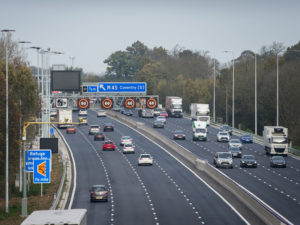Drivers support smart motorways but still unsure of rules, finds Venson
The majority of drivers welcome smart motorways to reduce congestion and emissions but some education is still required to improve safety – including by fleet managers.

56% of drivers in the Venson research agreed that smart motorways are necessary to help improve road safety and ease congestion
Research carried out by Venson Automotive Solutions among drivers found 56% agree that smart motorways are indeed necessary to help improve road safety and ease congestion.
Half (49%) see the benefits for congestion levels, and a quarter (23%) expect smart motorways to ease emissions. However, nearly one in 10 (9%) admit they don’t know what a smart motorway is, highlighting the need for driver education.
The research also shows more than a third (35%) of those surveyed don’t support the use of smart motorways, citing safety concerns as the main reason. Of this figure, 38% said they would not feel safe in case of a breakdown and being unable to reach an Emergency Refuge Area, while 35% believe it unsafe to use the hard shoulder as a running lane in peak times.
The research has been published as the RAC has called for further action on smart motorways, following an inquest into the deaths of two people on a smart motorway section of the M1 motorway. While the RAC has said that “some good progress” has been made on the Government’s smart motorway plan published in March 2020, including on adding more SOS areas to the M25 and developing a new standard for future schemes, it believes more work needs to be done.
Venson said that, used correctly, smart motorways have the potential to be safer and more efficient than standard motorways, but this requires drivers to fully understand and abide by their unique rules. And fleets also have a duty to educate drivers on using smart motorways safely, including on Highways England’s tips (below).
Marketing director Alison Bell commented: “Private motorists and company car and van drivers need to familiarise themselves with the dos and don’ts. Businesses also have a duty of care to ensure their drivers know the rules of smart motorways and use them appropriately and safely. Every driver must understand what to do in the event of a breakdown or emergency, take notice of the red X above a closed lane, stick to the variable speed limit and keep left as much as possible unless overtaking.”
Highways England quick tips on using smart motorways safely:
Don’t ignore the red X – Never drive in a lane closed by a Red X.
Hard shoulder – This is identified by a solid white unbroken line. If there’s no speed limit displayed above it or a Red X is displayed, do not use it except in emergency.
Stay within the variable speed limit – It’s there to steady the flow of traffic or if there’s a hazard ahead. Keep to the speed limits shown on the signs.
Keeping left is right – Keep left unless you’re overtaking, no matter how many lanes the motorway has.
Vehicle Problems – If your vehicle experiences difficulties, e.g. warning light, exit the motorway immediately or as soon as you can.
Know what to do in a breakdown – Where you can: get left, get out of the flow of traffic, get safe and get help. If the hard shoulder is being used as an extra lane, use the designated emergency areas for emergencies. Always put your hazard lights on and stand behind the motorway safety barrier while waiting for help.

















